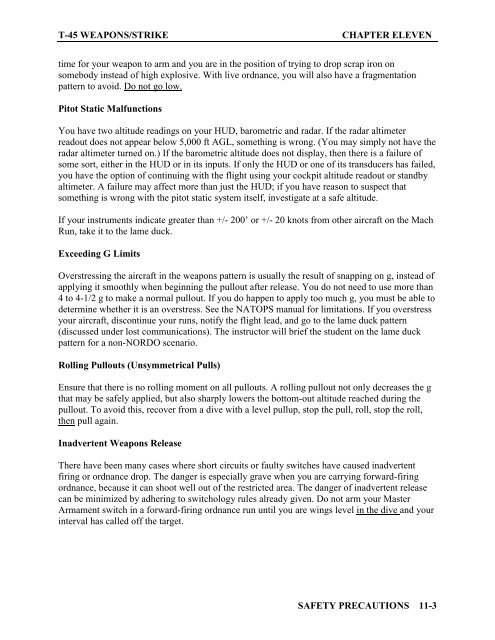FLIGHT TRAINING INSTRUCTION T-45 WEAPONS/STRIKE - Cnatra
FLIGHT TRAINING INSTRUCTION T-45 WEAPONS/STRIKE - Cnatra
FLIGHT TRAINING INSTRUCTION T-45 WEAPONS/STRIKE - Cnatra
Create successful ePaper yourself
Turn your PDF publications into a flip-book with our unique Google optimized e-Paper software.
T-<strong>45</strong> <strong>WEAPONS</strong>/<strong>STRIKE</strong> CHAPTER ELEVEN<br />
time for your weapon to arm and you are in the position of trying to drop scrap iron on<br />
somebody instead of high explosive. With live ordnance, you will also have a fragmentation<br />
pattern to avoid. Do not go low.<br />
Pitot Static Malfunctions<br />
You have two altitude readings on your HUD, barometric and radar. If the radar altimeter<br />
readout does not appear below 5,000 ft AGL, something is wrong. (You may simply not have the<br />
radar altimeter turned on.) If the barometric altitude does not display, then there is a failure of<br />
some sort, either in the HUD or in its inputs. If only the HUD or one of its transducers has failed,<br />
you have the option of continuing with the flight using your cockpit altitude readout or standby<br />
altimeter. A failure may affect more than just the HUD; if you have reason to suspect that<br />
something is wrong with the pitot static system itself, investigate at a safe altitude.<br />
If your instruments indicate greater than +/- 200’ or +/- 20 knots from other aircraft on the Mach<br />
Run, take it to the lame duck.<br />
Exceeding G Limits<br />
Overstressing the aircraft in the weapons pattern is usually the result of snapping on g, instead of<br />
applying it smoothly when beginning the pullout after release. You do not need to use more than<br />
4 to 4-1/2 g to make a normal pullout. If you do happen to apply too much g, you must be able to<br />
determine whether it is an overstress. See the NATOPS manual for limitations. If you overstress<br />
your aircraft, discontinue your runs, notify the flight lead, and go to the lame duck pattern<br />
(discussed under lost communications). The instructor will brief the student on the lame duck<br />
pattern for a non-NORDO scenario.<br />
Rolling Pullouts (Unsymmetrical Pulls)<br />
Ensure that there is no rolling moment on all pullouts. A rolling pullout not only decreases the g<br />
that may be safely applied, but also sharply lowers the bottom-out altitude reached during the<br />
pullout. To avoid this, recover from a dive with a level pullup, stop the pull, roll, stop the roll,<br />
then pull again.<br />
Inadvertent Weapons Release<br />
There have been many cases where short circuits or faulty switches have caused inadvertent<br />
firing or ordnance drop. The danger is especially grave when you are carrying forward-firing<br />
ordnance, because it can shoot well out of the restricted area. The danger of inadvertent release<br />
can be minimized by adhering to switchology rules already given. Do not arm your Master<br />
Armament switch in a forward-firing ordnance run until you are wings level in the dive and your<br />
interval has called off the target.<br />
SAFETY PRECAUTIONS 11-3
















